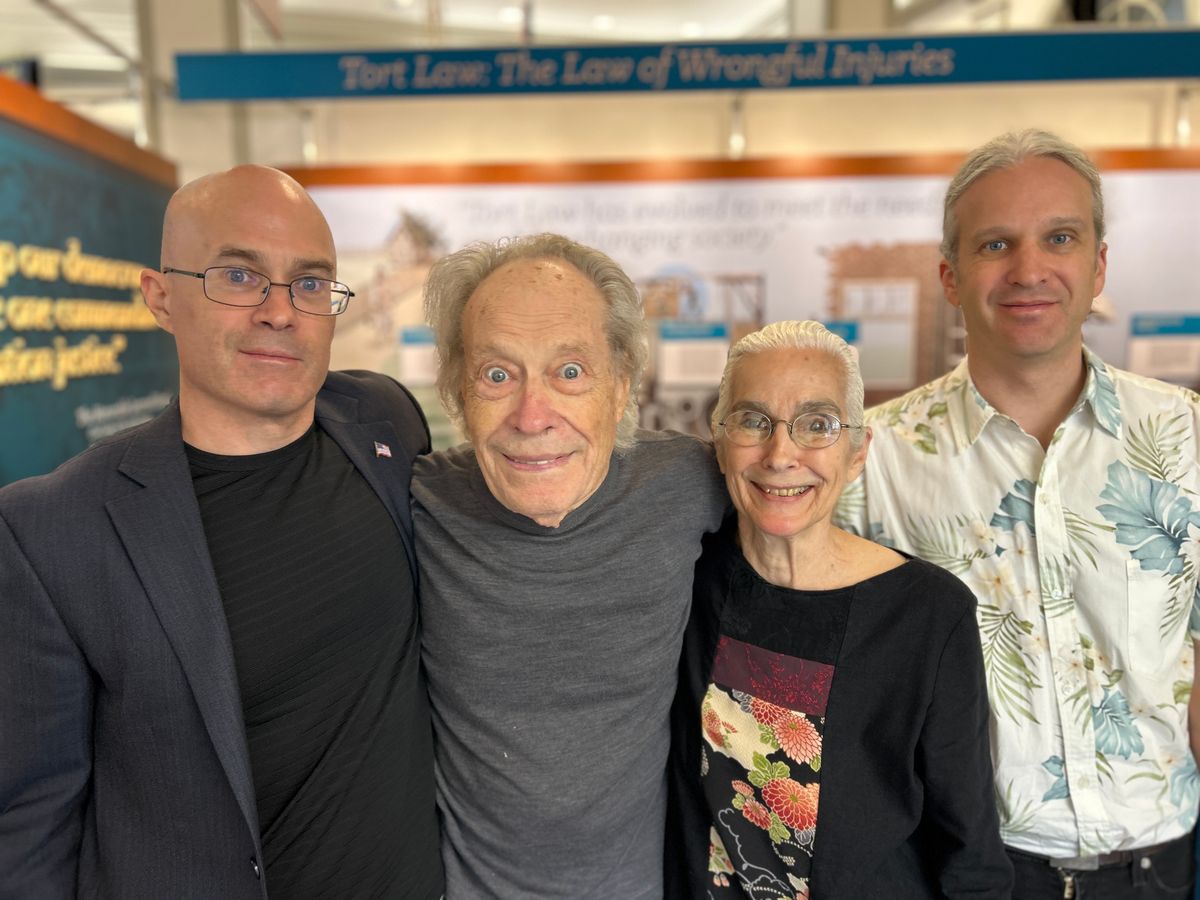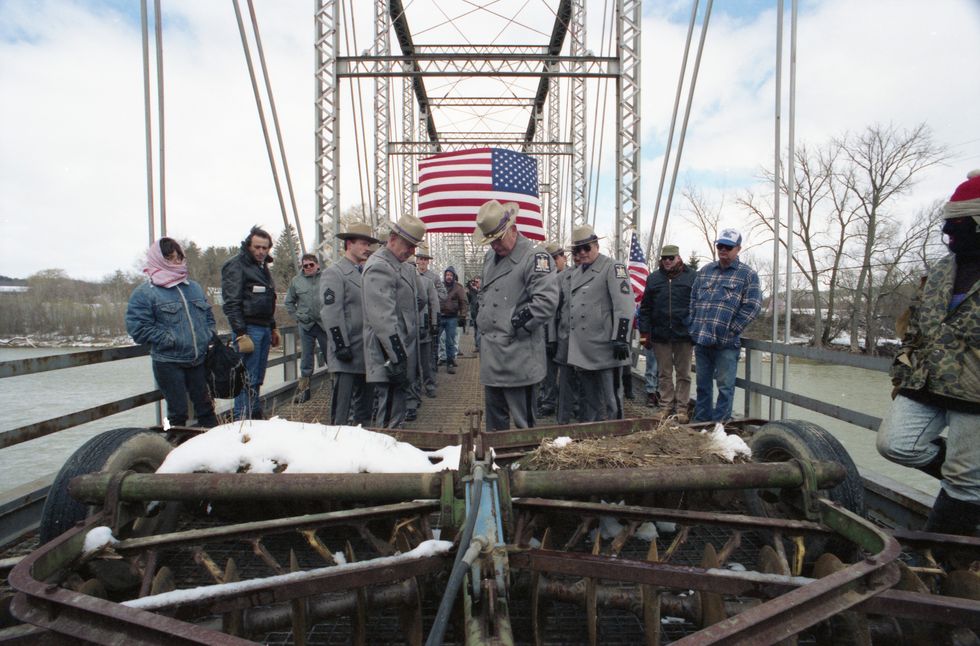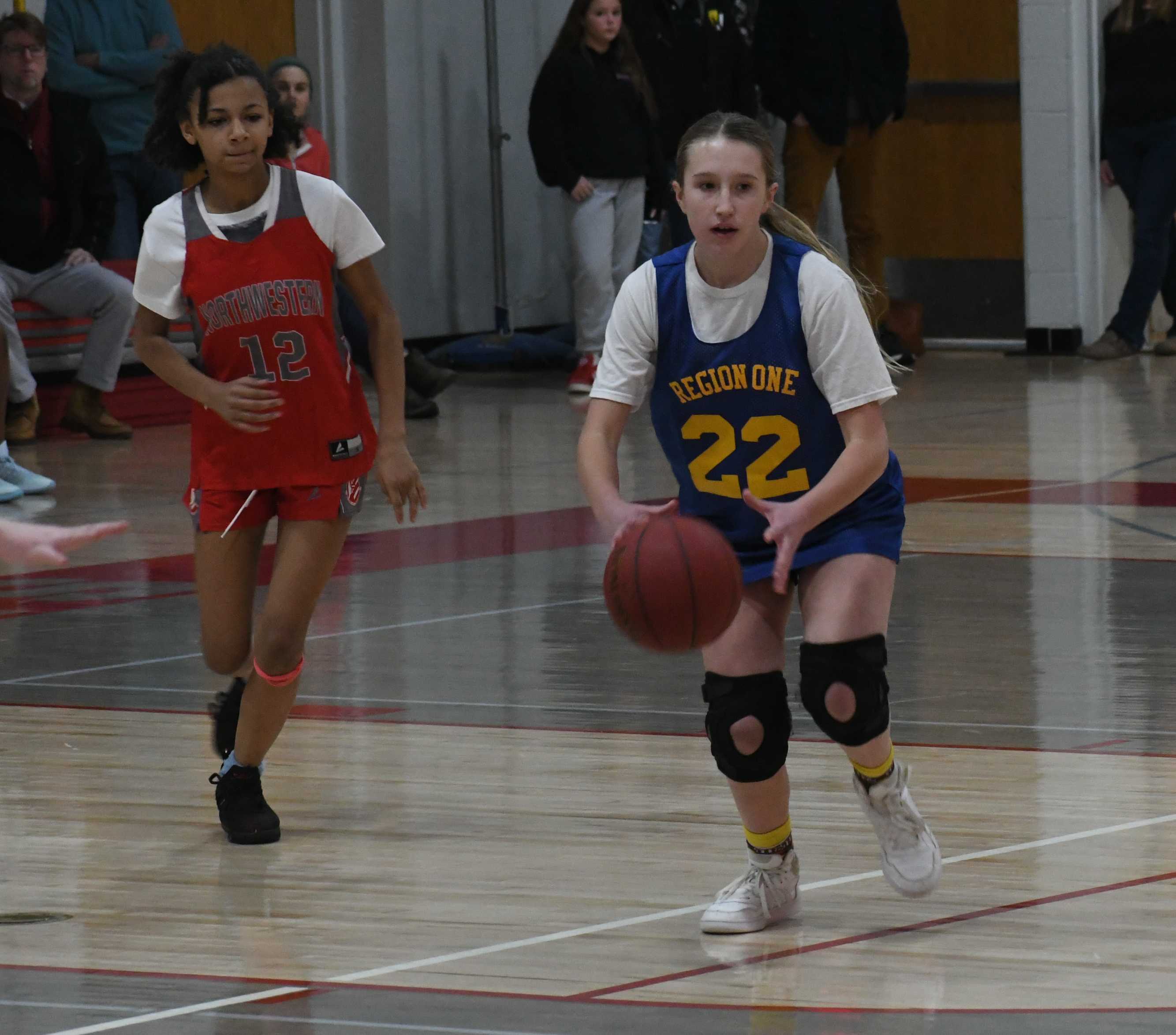Garden of Atoms: Family’s battle against radioactive dump

Left to right: Matthew L. Myers, Stephen Myers, Betsy Myers, and Shepherd P. Myers.
Jennifer Almquist

Left to right: Matthew L. Myers, Stephen Myers, Betsy Myers, and Shepherd P. Myers.
WINSTED — “It only takes a few people to start something,” began Betsy Myers in her hour-long presentation Aug. 17 at Ralph Nader’s American Museum of Tort Law.
Myers, her husband Stephen Myers, and sons Shepherd and Matthew, who now live in Salisbury, recalled together their epic battle against the siting of a low-level nuclear waste facility (including high-level waste by dilution) by New York state in their rural town of Almond. The New York State Radioactive Waste Siting Commission was under a federal mandate to find a home for nuclear waste.
Allegany County, next to the Pennsylvania border, was one of the possible sites. Almond is an isolated farming community in that county, where the Myers family moved in 1979 with their young sons. They left New York City to have a quieter life. They both taught in the rural central school. When they learned of plans for locating a nuclear waste site 10 miles from their home, they immediately began getting the word out into the community.
Betsy and Stephen started small, sharing the information with the folks that hung out at the local pub, Mulhesian’s Bar. Myers, who resembles artist Georgia O’Keefe, recalled “I worked the crowd in the bar, said we must fight against the dumping of nuclear waste in our county, and they said I was a dreamer.”
Thus began an amazing struggle pitting a rural farm community against the powers of New York State, Governor Mario Cuomo and Congressman Amory Houghton, Jr. Houghton, the wealthiest member of congress at that time, was an heir to the Corning Glass Works fortune. He recognized potential profit for his family business in the siting of the nuclear waste facility. A process called vitrification basically encased the nuclear material in glass (a concept that has since proven flawed), was seen at the time as a means of safely disposing of nuclear waste. If implemented, the process could have meant a fortune to Corning Glass Works, according to Myers.
The Myers duo founded Concerned Citizens of Allegany County (CCAC), a community-based grassroots organization. When the group held their first community meeting in Belfast, New York, on Jan. 26,1989, 5,000 people showed up, out of a population of 16,000 in the county. It was a mixture of hardscrabble farmers and highly educated professors.
Myers explained that it was a complicated group to appeal to. She said, “There were a lot of guns in the county, and some really tough locals. We wanted peaceful protests – no guns, no knives, no violence. It is enduring that everyone bonded against nuclear waste.”

Governor Cuomo, who aspired to become President, came to the area to purportedly to give a grant to the Alfred University’s ceramics school, but his real purpose was to check out the tales of a radical “Bump the Dump” campaign. At that time there were a handful of commercial dump sites proposed for spent reactor fuel up and down both coasts. Congressman Houghton took Steve Myers to Barnwell, South Carolina, to show him a “successful” nuclear site. To Houghton’s chagrin, Myers brought a Geiger counter with him, and came home to Almond stating, “there is no safe storage.” [Note of interest; the current 235-acre low level-radioactive waste disposal site in Barnwell County receives waste from South Carolina, New Jersey, and Connecticut.]
The dire nature of the problem galvanized the people to block all efforts of the State Siting Commission from entering the county. Every vehicle in town — cars, trucks, and farm tractors — parked on both sides of the street blocking access, someone put a dead skunk into the exhaust fan of the Siting Commissioner’s RV. They marched to Albany carrying wooden caskets representing the potential towns under consideration as sites. Two farmers welded shut the bridge to keep them from entering town. Wearing a red arm band meant you were willing to be arrested, a yellow arm band indicated you were a supporter.
Some state official referred to the locals as “people kept in the dark and fed mushrooms.” Thus, was born the paper mushroom masks that all the protestors wore to protect their identity from the recent injunction against them. Anyone recognized by the State Police would receive 30 days in jail and a $1,000. fine.
As the State increased pressure on the people, they began pushing back harder. Men rolled giant snowballs to block the roads, and parked every manner of combine, bailer, and mower across the bridge. During the final site Commission visit, a bunch of elders blocked the Caneadea Camelback Bridge by handcuffing themselves to a chain across the span. They became known as “Grandparents for the Future.”
Some of the protesters had ridden in on their workhorses. An overzealous State Police captain moved in, arrested the men, and ordered his troopers to beat the horses. “We were on our horses and the troopers beat some of our riders into the mud,” recalled Glen Zweygardt. That was the final straw. Myers said to a hushed crowd at the American Tort Museum, “NY State lost, the night they beat the horses.” The next day Cuomo ordered the commission to suspend their surveys.
The activists’ legal challenge questioning the constitutionality of the siting process at the state level, based on the Tenth Amendment concerning state’s rights, moved through the courts, 13,000 residents signed a petition, and their case was eventually heard in 1992 by the Supreme Court, who ruled in favor of the people in New York v. U.S.et al, which determined that “Congress cannot force states to assume ownership and liability of low-level radioactive waste within its borders.” It was a hard-fought victory.
The legal documents, correspondence, newspaper clippings, buttons, posters, tee-shirts, even the mushroom masks, are held in a level II security vault at Cornell University, donated by both Myers’ sons. The Myers Collection is stored alongside a copy of the Gettysburg Address. The legacy of the grassroots movement begun by Stephen and Betsy Myers to protect the safety of their children and their neighbors from nuclear poisoning, still resonates in every small town and city in America.
The Region One boys basketball team huddles up during a break in the game against Northwestern Thursday, Jan. 15.
Middle school basketball players battled on the courts of Northwestern Regional High School in Winsted Thursday, Jan. 15. Region One’s boys and girls teams took on Region Seven in side-by-side games. Region One’s team includes players from Cornwall, Falls Village, North Canaan, Salisbury and Sharon. Region Seven includes Barkhamsted, Colebrook, New Hartford and Norfolk.
The boys game was won by Region One 62-41. The girls game was won by Northwestern 27-14.
Athletes in both games played with intensity and passion.

Canon Petero Sabune addresses the congregation at St. John’s Episcopal Church Sunday, Jan. 18.
SALISBURY — St. John’s Episcopal Church marked the Martin Luther King Jr. holiday weekend by welcoming Canon Petero Sabune for a special service on Sunday, Jan. 18, followed by a visit to Salisbury School the next day.
King’s legacy and faith were central themes throughout the service. The first reading featured an excerpt from King’s final book, “Where Do We Go From Here: Chaos or Community?” including the oft-quoted passage: "Returning violence for violence multiples violence, adding deeper darkness to a night already devoid of stars. Darkness cannot drive out darkness: only light can do that. Hate cannot drive out hate: only love can do that.”
In his sermon, Sabune said that many accounts of King’s life and influence often “forget about his faith and convictions.”
“He was a baptized disciple of Jesus Christ,” Sabune said.
After the service, Sabune was asked about ongoing protests and controversy in Minneapolis. He noted that King’s philosophy of nonviolent resistance was shaped by Mahatma Gandhi, who in turn drew inspiration from the writings of Henry David Thoreau.
Sabune said civil rights workers and protestors in the 1950s and 1960s underwent formal training in nonviolence. “They taught people how to get hit and not respond, what [civil rights figure and congressman] John Lewis called ‘good trouble,’” he said.
Reflecting on more recent events, Sabune said that when considering the circumstances that led to the death of Renee Good at the hands of Immigration and Customs Enforcement agent Jonathan Ross, “I feel the pain, not just for Renee, but for Officer Ross.”
Music also played a prominent role in the service. The hymns were drawn from “Lift Every Voice and Sing II: An African-American Hymnal.” Among them was “Precious Lord,” which King requested be sung the night before his death.
“Sing ‘Precious Lord’ and sing it pretty,” King told a follower.
Sabune’s visit to Salisbury followed a long journey that began with a bus ride from Tucson, Arizona, to Phoenix on Saturday, Jan. 17, followed by an overnight flight. The Rev. Johan Johnson, priest-in-charge at St. John’s and chaplain at Salisbury School, picked him up at 7 a.m. Sunday.
The two men have known each other for so long they cannot recall exactly where or when they first met. During an interview, Sabune paused to greet Johnson’s youngest daughter, whom he baptized.
As he headed toward the reception, where parishioners were waiting to greet him, Sabune was asked one final question:
“You going to get a nap in today?”
“Yes!” he said emphatically over his shoulder as he hurried up the aisle.
CORNWALL — A public hearing was held Tuesday, Jan. 13, to consider the creation of the West Cornwall General Business (WCBG) district.
The proposed zoning text amendment was submitted to the Planning and Zoning Commission in response to longstanding difficulties faced by West Cornwall business owners seeking to modify nonconforming buildings that do not meet current zoning requirements.
The amendment would establish the WCBG district as a separate zone, distinct from the existing business district in Cornwall Bridge. Within the new district, applicants are seeking to reduce the minimum lot size from one acre to 10,000 square feet, narrow the minimum lot width from 100 feet to 50 feet, and eliminate minimum front, side and rear setback requirements.
Most buildings in the area predate modern zoning regulations and were constructed directly on property lines, planning consultant Martin Connor told the commission on behalf of the applicants, West Cornwall Development Group LLC.
As a result of their nonconforming status, Connor said, many property owners have been unable to make even modest improvements. He cited the Pink House as an example, noting that its owners currently store buckets and mops outdoors because they are not permitted to construct a small exterior storage closet behind the building.
Public comment was mixed, with residents voicing both concern and support. Some speakers raised questions about safety and the potential impacts of the proposed changes, while others said the amendment would help bring long-standing nonconforming properties into compliance and create a more business-friendly environment. One resident asked the commission to allow additional time to review the application.
First Selectman Gordon Ridgway spoke in favor of the proposal, saying the current zoning framework “makes it very hard for any business to expand.” He added, “Having large amounts of property being zoned as nonconforming is bad planning, especially as we have for years tried to revive our business centers.”
After closing the public hearing, the commission discussed the proposal during its regular meeting and considered modifications before voting.
Commissioners focused their discussion on the proposed setback distances, citing fire safety concerns tied to the village’s historic character and the age of many buildings.
“Most of these buildings are old. They’re not built with fire blocking,” said Christine Gray, a commission member.
James LaPorta, also a commission member, raised similar concerns about safety and setbacks. “To have a zero side setback, I think, is asking for trouble in the long run. I think five [feet] would be fine.”
Commissioners said eliminating side setbacks entirely could create long-term safety risks and discussed whether a modest buffer would better balance flexibility for property owners with public safety considerations.
Commissioners also emphasized that any future applications within the district would still require review and approval by the Planning and Zoning Commission, as well as other relevant boards, including the Inland Wetlands & Watercourses Agency, the fire marshal and the Torrington Area Health District.
Chair Anna Timell moved to approve the application with a modification setting the side and rear setbacks at five feet, while reducing the front setback to zero feet. She cited the town’s Plan of Conservation and Development, which calls for reviewing and revising zoning regulations in business zones.
The motion passed unanimously.
Moving company
Commissioners also approved a site plan application for Karls on Wheels, a moving company proposing to locate at 26 Kent Road.
The plan includes no change to the footprint and no change in use, and does not permit self-storage on the site.
The application was approved unanimously.
Edward Aparo passed away peacefully at his home on January 7, 2026 surrounded by his loving family.
Edward was born on May 10, 1936 in New Britain, CT. He was the beloved son of the late Anthony and Rose Valenti Aparo and attended New Britain schools. On April 7, 1958 Edward married his school sweetheart Jean Ackerman beginning a devoted marriage that spanned 67 years. Together they built a life rooted in family, hard work and love.
Edward began his career working in the family business, Aparo’s Electric Motor Service Inc. where he learned the trade alongside his father. Following his father’s passing, Edward became the owner of the business, carrying on the family legacy with dedication and pride. Edward is survived by his loving wife Jean Ackerman Aparo, his sons Stephen Aparo and his wife Marie of New Britain, CT and Craig Aparo and his wife Valerie of Naples, Fl, his sister Arlene Aparo StGermain and husband Joseph of Hobe Sound FL and his cherished grandchildren Danny Aparo and wife Nicole, Tyler Aparo and Morgan Wilson and Jared Aparo all of New Britain.
Services with be private.